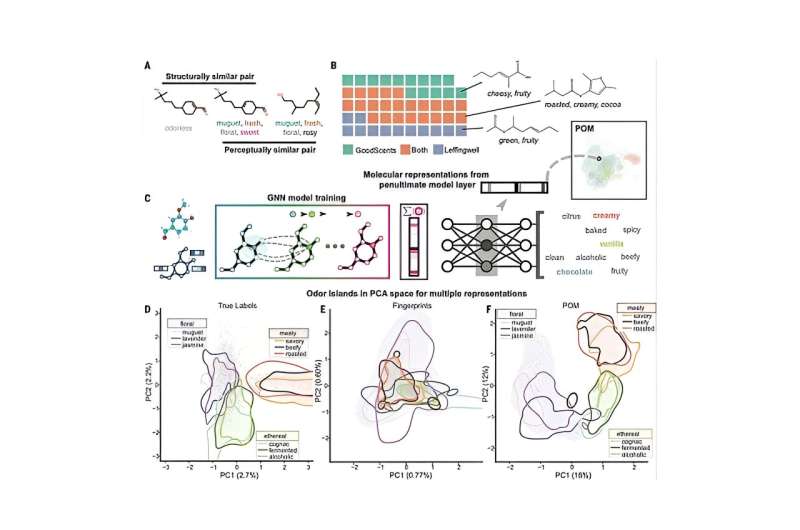This article has been reviewed according to Science X's editorial process and policies. Editors have highlighted the following attributes while ensuring the content's credibility:
fact-checked
peer-reviewed publication
trusted source
proofread
AI 'nose' predicts smells from molecular structures

In a major breakthrough, scientists have built a tool to predict the odor profile of a molecule, just based on its structure. It can identify molecules that look different but smell the same, as well as molecules that look very similar but smell totally different. The research was published in Science.
Professor Jane Parker, University of Reading, said, "Vision research has wavelength, hearing research has frequency—both can be measured and assessed by instruments. But what about smell? We don't currently have a way to measure or accurately predict the odor of a molecule, based on its molecular structure."
"You can get so far with current knowledge of the molecular structure, but eventually you are faced with numerous exceptions where the odor and structure don't match. This is what has stumped previous models of olfaction. The fantastic thing about this new ML generated model is that it correctly predicts the odor of those exceptions."
The research applied machine learning to create an 'odor map' that will be invaluable in the work of synthetic chemists in the food and fragrance industries. It may also open up avenues for the production of more sustainable flavors and fragrances.
Professor Parker said, "As a flavor chemist, I've worked on smell for many years, relying mainly on my own nose to describe aromas.
"The map doesn't just work for known odorants, and those that are structurally very similar. It can describe a wide subset of unrelated molecules with different molecular characteristics.

"For researchers across food and fragrance, this opens up an untapped source of thousands, or possibly millions, of potential odorants."
Professor Parker worked with colleagues at the Monell Chemical Senses Center at the University of Pennsylvania, Arizona State University, and Osmo, a company that was spun out of Google's machine learning lab.
The University of Reading's role was to assess the purity of the samples used to test the AI. We verified the purity of the compounds used to test the AI model's prediction. Gas chromatography enabled us to separate the trace levels of impurities and the target molecule so, as they eluted one- by-one from the instrument, we could smell all the individual molecules and determine whether the smell of any of the trace compounds was overwhelming (or masking) the odor of the target molecule.
"We did find a few samples with significant impurities, among the 50 tested. In one case, the impurity we could smell was traces of the reagent used in the synthesis of the target molecule and gave the sample a distinctive buttery smell that overpowered the odorant we were actually interested in. In this case we were able to explain why the panel had described the smell as buttery but this did not fit with the model's prediction, whereas our descriptor of the pure compound did."
Once the AI had been taught with data, its ability to predict the smell of a novel compound was excellent. If working correctly, it should match the average scent scores of a panel of humans, which it did.
Dr. Parker said, "As a tool for synthetic chemistry, this will be invaluable. We can use it to seek out new aromas. It opens the possibility to screen large numbers of molecules for aroma, just like the pharmaceutical industry does for new medicines."
More information: Brian K. Lee et al, A principal odor map unifies diverse tasks in olfactory perception, Science (2023). DOI: 10.1126/science.ade4401. www.science.org/doi/10.1126/science.ade4401
Journal information: Science
Provided by University of Reading





















